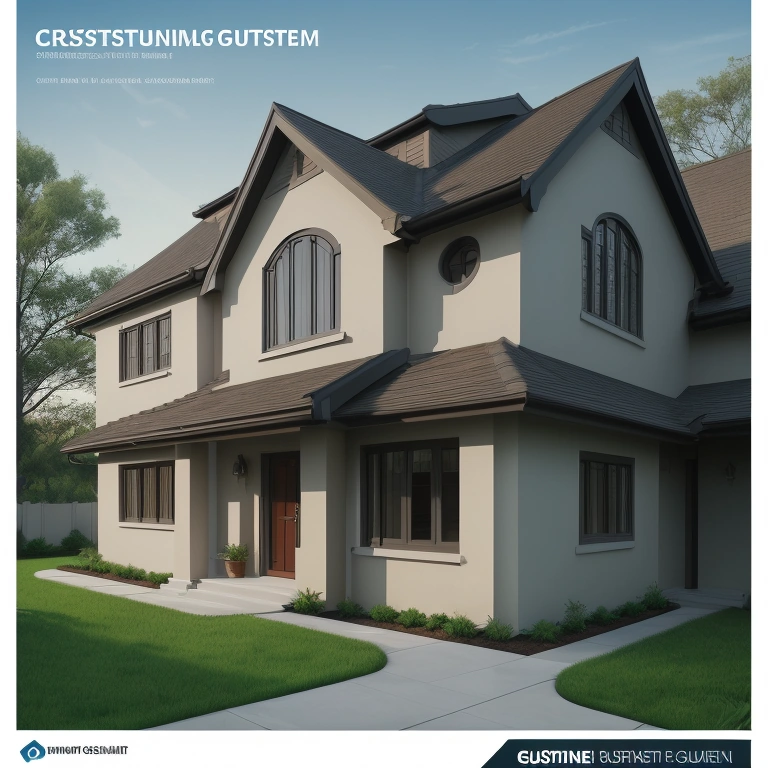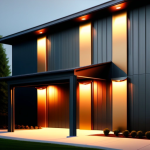Comprehensive Gutter System Design Guide: Protecting Your Home from Water Damage
Beyond the Basics: Why Gutter System Design Matters
The unsung hero of home protection, the gutter system, often goes unnoticed until disaster strikes. A properly designed and maintained gutter system is crucial for diverting rainwater away from your home’s foundation, siding, and landscaping, preventing costly water damage. This guide provides an in-depth look at the essential elements of gutter system design, from material selection to installation best practices, ensuring your home remains protected for years to come. Think of your gutter system as the first line of defense against the elements; neglecting its design and upkeep is akin to leaving a door unlocked during a storm.
A compromised gutter system can lead to a cascade of problems, from basement flooding and structural damage to mold growth and landscape erosion, significantly impacting your home’s value and your family’s well-being. Effective gutter design goes beyond simply attaching troughs to your roofline. It requires a comprehensive understanding of your home’s architecture, local climate patterns, and the specific materials best suited to withstand those conditions. For example, a homeowner in a region prone to heavy snowfall should prioritize robust gutter materials like steel or heavy-gauge aluminum and ensure proper sizing to handle the increased water volume from melting snow and ice.
Similarly, the pitch of your roof and the square footage it covers directly impact the required gutter capacity and the number of downspouts needed for efficient water drainage. Consulting with a qualified roofing or home improvement professional can provide invaluable insights into tailoring a gutter system that meets your property’s unique needs. Beyond the functional aspects, gutter design also presents an opportunity to enhance your home’s exterior aesthetics. Seamless gutters, for instance, offer a sleek, modern look by minimizing visible seams and joints, contributing to a cleaner roofline. Gutter materials like copper not only provide exceptional durability but also develop a beautiful patina over time, adding character and curb appeal. Furthermore, integrating gutter guards into your design can significantly reduce maintenance demands while maintaining optimal performance. Investing in a well-designed and aesthetically pleasing gutter system is a smart home improvement decision that protects your property and elevates its overall appearance.
Material Selection: Aluminum, Steel, Vinyl, and Beyond
Choosing the right materials for your gutter system is paramount, a decision that directly impacts both the effectiveness and longevity of your home’s water management strategy. Options range from traditional aluminum to durable steel, low-maintenance vinyl, and aesthetically pleasing copper, each presenting a unique blend of benefits and drawbacks. Aluminum is a popular choice for gutter systems due to its affordability, lightweight nature which simplifies gutter installation, and resistance to rust. However, its lower strength compared to steel makes it more susceptible to denting and damage from falling branches or heavy ice loads.
Steel offers superior strength and longevity, particularly in areas with heavy snow or ice, making it a robust choice for demanding climates. While steel gutter systems can withstand significant weight and impact, they are prone to rust if the protective coating is compromised, requiring diligent gutter maintenance. Vinyl gutters are rust-proof and easy to install, often appealing to homeowners seeking a DIY gutter installation approach. Their lightweight nature and snap-together design simplify the process, but vinyl can become brittle and crack in extreme cold, limiting its lifespan in certain regions.
Copper provides a classic look, developing a distinctive patina over time, and can last for decades with minimal gutter maintenance. However, copper gutter materials are significantly more expensive than other options, making them a premium choice for homeowners prioritizing aesthetics and long-term durability. The choice of gutter materials should also align with the roofing material to prevent galvanic corrosion, which can occur when dissimilar metals come into contact in the presence of moisture. Beyond these common materials, specialized options like zinc and fiberglass are also available, catering to niche applications and design preferences.
Zinc offers excellent corrosion resistance and a lifespan comparable to copper, making it a sustainable choice for environmentally conscious homeowners. Fiberglass gutters are incredibly strong and lightweight but tend to be more expensive and require professional gutter installation. Considering factors such as local climate, budget, aesthetic preferences, and the architectural style of your home is crucial when selecting gutter materials. For example, homeowners in coastal areas should strongly consider aluminum or vinyl due to their inherent resistance to saltwater corrosion, while those in colder climates might opt for steel or heavy-gauge aluminum to withstand the formation of ice dams and the weight of accumulated snow. Ultimately, selecting the right gutter materials is a critical investment in protecting your home from costly water damage.
Sizing and Capacity: Ensuring Adequate Water Flow
Gutter sizing and capacity are critical factors in preventing overflows and water damage, effectively safeguarding your home’s structural integrity and exterior aesthetics. Gutters are typically sized at 5 or 6 inches, with larger, industrial-sized gutters often necessary for commercial buildings or homes with expansive roofing. The choice depends significantly on roof surface area and pitch; steeper slopes accelerate water runoff, demanding greater gutter capacity. For instance, a house with a 4,000-square-foot roof and a moderate slope might require 6-inch gutters paired with larger downspouts, while a smaller home with a less severe pitch could suffice with standard 5-inch gutters.
Ignoring these calculations can lead to water cascading over the sides, damaging landscaping, siding, and eventually, the foundation. Therefore, understanding the nuances of gutter sizing is a cornerstone of effective gutter system design. Downspouts, the vertical conduits that channel water away from the foundation, must be adequately sized and spaced to handle the water volume efficiently. Insufficient downspouts can lead to clogs and overflows, defeating the purpose of the entire gutter system and potentially causing costly water damage.
A general rule of thumb is one downspout for every 30-40 feet of gutter, but this is a simplified guideline. Factors like the intensity of rainfall in your region and the presence of trees that shed leaves into the gutters should also be considered. For example, a home in the Pacific Northwest, known for its heavy rainfall, would likely require more downspouts than a similar-sized home in a drier climate. Proper downspout placement is also crucial; directing water at least 10 feet away from the foundation prevents water from pooling and seeping into the basement.
To accurately determine the appropriate gutter and downspout sizes, consulting with a professional gutter installation specialist is highly recommended. These experts use sophisticated calculations, often incorporating local rainfall data from sources like the National Weather Service, to tailor the gutter system to your specific property. They consider the roof’s square footage, pitch, and the average rainfall intensity in your area. Furthermore, they can advise on the optimal placement of downspouts to ensure efficient water drainage. Neglecting this crucial aspect of gutter design can result in significant water damage over time, ultimately negating any perceived cost savings from DIY gutter installation attempts. Investing in professional sizing and installation ensures long-term protection and peace of mind, safeguarding your home from the detrimental effects of water damage and preserving its exterior appeal.
Installation Techniques: Best Practices for Longevity
Proper installation is key to the long-term performance of your gutter system. Securely attaching gutters to the fascia board with appropriate hangers is essential to prevent sagging and detachment. The gutter system should be sloped slightly towards the downspouts to facilitate water flow, typically at a pitch of about a quarter-inch per ten feet. Seams and joints should be properly sealed to prevent leaks, utilizing high-quality sealant specifically designed for exterior applications. While DIY gutter installation may seem appealing, particularly for straightforward runs, professional installation ensures proper alignment, secure attachment, and leak-proof connections, mitigating the risk of future water damage.
This is especially important for complex rooflines or multi-story homes where precise measurements and specialized equipment are necessary. Beyond the basics, professional gutter installation often involves a comprehensive assessment of your home’s unique needs. Experts can determine the optimal placement and number of downspouts based on rainfall patterns and roof surface area, ensuring efficient water drainage. They can also advise on the best gutter design and gutter materials to complement your home’s exterior and withstand local weather conditions.
For example, in areas prone to ice dams, heated gutter systems or specialized gutter guards designed to prevent ice buildup may be recommended. Furthermore, a professional installer will ensure the gutter system integrates seamlessly with your roofing, preventing potential damage to the roof itself. Moreover, reputable gutter installation companies typically offer warranties on their workmanship, providing added peace of mind. These warranties often cover issues such as leaks, sagging, and detachment, offering financial protection against installation errors. Before committing to a DIY approach, consider the potential costs associated with improper installation, including water damage repairs, material waste, and the time investment required. Investing in professional gutter installation can ultimately save you money and headaches in the long run, ensuring your home is adequately protected from water damage for years to come. This is particularly important when considering the long-term value and structural integrity of your home improvement investment.
Maintenance and Longevity: Protecting Your Investment
Regular maintenance is paramount to ensuring your gutter system functions optimally, safeguarding your home from potential water damage. The cornerstone of this maintenance is the removal of leaves, twigs, and other debris that inevitably accumulate and obstruct water flow in gutters and downspouts. Clogged gutters can lead to water backing up onto the roof, potentially causing leaks and damage to roofing materials. Furthermore, the added weight of water-saturated debris can stress the gutter system itself, leading to sagging, detachment from the fascia board, and premature failure.
Addressing these issues promptly is a key aspect of responsible home improvement and preventative exterior design. Gutter guards offer a proactive approach to minimizing debris accumulation, acting as a barrier against larger objects while allowing water to flow freely. Various types of gutter guards are available, including mesh screens, surface tension guards, and foam inserts, each with its own advantages and disadvantages in terms of cost, effectiveness, and maintenance requirements. While gutter guards can significantly reduce the frequency of manual cleaning, they are not a complete substitute.
Periodic inspections are still crucial to ensure the guards themselves are free from debris buildup and that the underlying gutters remain clear. For instance, fine debris like pine needles or shingle granules can still accumulate over time, even with gutter guards in place, potentially impeding water flow. Investing in quality gutter materials and gutter installation techniques initially will only go so far without consistent maintenance. Neglecting gutter maintenance can have cascading consequences, leading to costly repairs and diminished curb appeal.
Overflowing water can saturate the soil around your home’s foundation, potentially causing cracks and structural damage. Water running down siding can lead to staining, mold growth, and wood rot. Furthermore, uncontrolled water runoff can erode landscaping, damaging plants and creating unsightly puddles. A proactive gutter maintenance plan, including regular cleaning and inspections, represents a small investment compared to the potential costs associated with water damage. By prioritizing gutter system upkeep, homeowners can protect their property’s value, prevent costly repairs, and maintain the aesthetic integrity of their exterior design.


